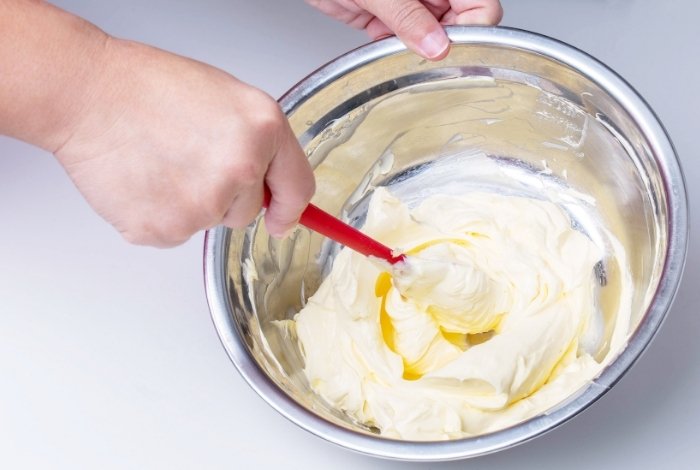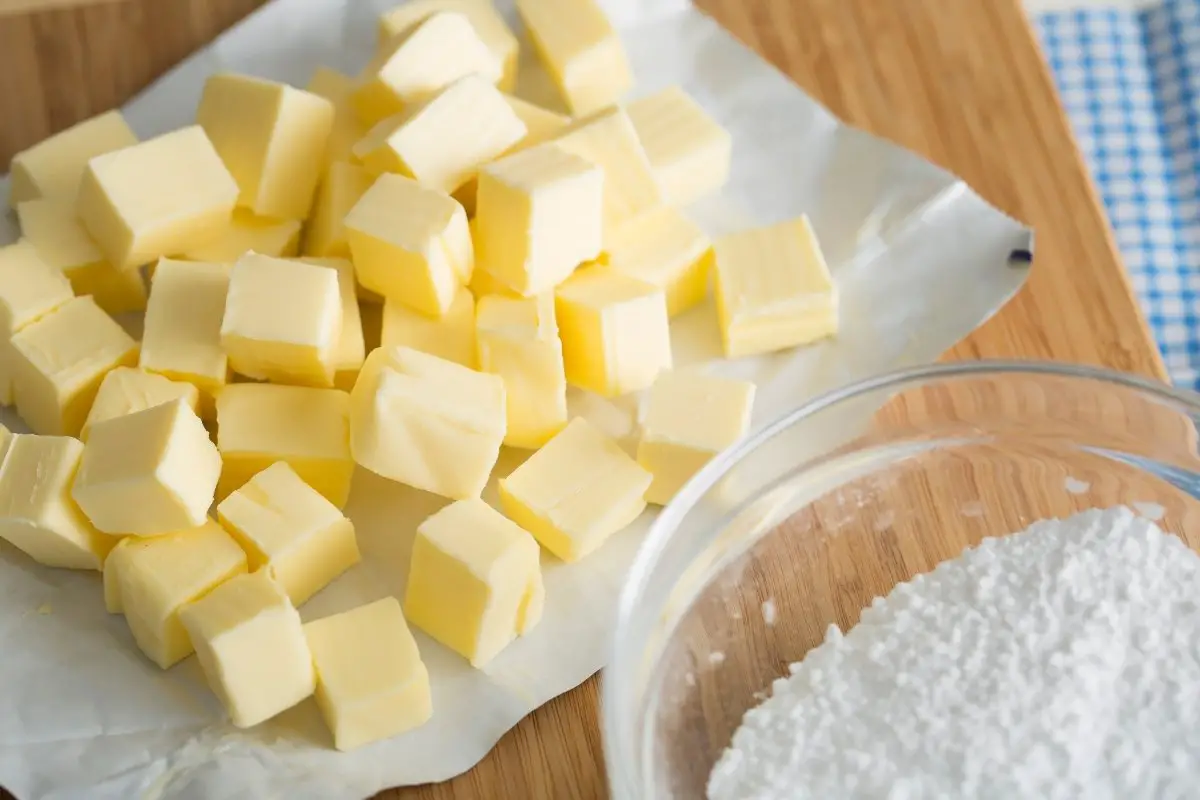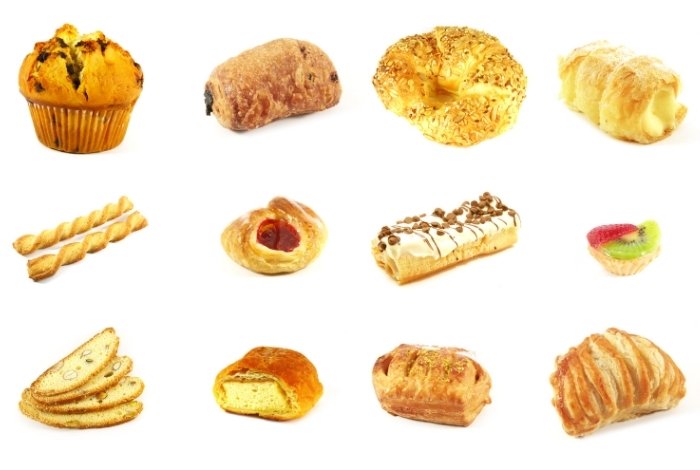Last Updated on February 16, 2023
Butter is a staple ingredient in many desserts. From brownies, cookies, cakes, frostings, pastries, biscuits, and more, butter is key to a delicious dessert. Since so many baked goods call for it, you may have wondered, what does butter do in baking?
Many bakers will always have butter on hand as it gives desserts a rich flavor and delicious texture. It is one of the most common baking ingredients and is an important aspect of many recipes.
From Flaky Croissants to Decadent Cakes: What Does Butter Do in Baking – One Delicious Bite at a Time!
Butter works as a fat in baking, while also helping with leavening, structure, flakiness, and moisture. It also provides a decadent flavor that gives desserts their delicious flavor.
Since butter is a solid fat, it is often the best option out of any fat products when baking. It creates moist cakes, creamy frostings, flaky pastries, and soft biscuits.

Flavor
Butter provides a rich, delicious flavor to baked goods. It is an important ingredient in the overall taste of desserts. In addition, it makes cakes and cookies moist, which enhances the flavor and texture.
Delicate Crumb
Fats slow down the formation of gluten which creates a tender crumb. When combined with flour, butter creates a barrier between protein and water. This is why bread made with butter, such as brioche and cinnamon rolls, is richer than baguettes and sandwich bread.
Leavening
Since butter is a solid fat, it helps baked goods rise. Creaming butter and sugar incorporates air into the mixture and provides a lift while baking. In addition, butter contains water and when evaporated it creates flaky pastries and pie crusts.
Unsalted Vs Salted Butter
When shopping at the grocery store, you will see salted and unsalted butter sold right next to each other. Most bakers prefer to use unsalted butter when baking, as this allows you to control the exact salt content.
Different brands add different amounts of salt to butter. This can make it difficult to know how much salt you are adding to your recipe. In baking, too much salt can hurt the taste of the final product. For example, the best butter for puff pastry is one that has a high butterfat content and is unsalted.
Sticking to unsalted butter is generally the best option when baking. This allows you to add the exact amount of salt the recipe calls for, resulting in a better-tasting final product. Though salted butter can be great for cooking, stick with unsalted butter when baking.
Using Room Temperature Butter Vs Melted Butter
The temperature of the butter plays an important role when baking. In most cases, you will use room-temperature butter or melted butter. However, for biscuits, pies, and pastries, you will use cold butter.
The temperature of butter affects how it interacts with the other ingredients, playing an important role in the texture of the baked good. Almost every recipe will specify if your butter should be at room temperature, cold, or melted.
Room temperature butter is softened so it can easily cream together with sugar. It creates an even distribution of fat in the baked good which results in a tender texture.
OYV Whisk, Whisks for Cooking Silicone Mini Whisk 3 Pack
Recipes that call for melted butter rely on butter for taste but not structure. It can result in flavorful, chewy cookies. Pancakes, waffles, and brownies will often call for melted butter to provide a delicious flavor.
Cold butter is used when you don’t want the butter to combine with the other ingredients in the recipe. This results in a delicious flaky texture with distinct layers, which is found in pastries, pie crusts, and biscuits.
Using Butter Vs Oil in Baking
Another common fat used in baking is oil. Vegetable oil and canola oil are common oils that can be used as fat. Butter is considered to be a solid fat and oil is considered to be a liquid fat.
Oil isn’t relied on as a leavening agent, but it often provides a denser texture. In addition, it adds a more neutral flavor. There are benefits of using butter and oil as the fat in baked goods. It is best to stick with what the recipe calls for, as they serve slightly different purposes, to get the best-tasting dessert.
Let Muffins Be Your Sweet Escape: The Delicious and Versatile Snack That’s Always There for You!
Muffins, oh muffins! They are like little pockets of joy, the perfect pick-me-up snack, the best thing that ever happened to breakfast! Muffins are the kind of food that makes you feel like everything is going to be alright, even on the most stressful of days.
But what are muffins, exactly? They are small, round, sweet, or savory baked goods that are made from a simple batter. In addition, muffins can be made in a variety of flavors, from classic blueberry to decadent chocolate chip to savory corn and cheese. Not to mention the texture, which may be light and fluffy or dense and hearty, depending on the recipe. What’s more, the best part? Muffins are very simple to make, even for inexperienced bakers.
Furthermore, perhaps the best thing about muffins is the way they make you feel. There is just something about biting into a warm, freshly baked muffin that makes everything better. Whether you’re having a bad day, or you just need a little pick-me-up, muffins are there for you, ready to offer comfort and deliciousness in equal measure.
Now that we are familiar with one of the star players of this narrative, let’s dive into specifics relating to this issue that might be of great value to you the next time you ask yourself “what does butter do in baking”.
From bland to blissful: How butter works its magic in muffins!
As previously said, butter is a magical ingredient in muffins that adds flavor, texture, and richness to almost all delicious, baked goods. Frankly speaking, it is the secret ingredient that elevates muffins from acceptable to amazing, tasty to mouthwatering, and fine to OMG. So, what does butter do in muffins? Let’s analyze it, shall we?
Taste is one of the first factors on this, in the first place, endless list. Specifically, no muffin can taste full flavor without at least a little fat. It’s the primary source of fat in the batter, and it gives the muffins a rich, buttery taste that makes your taste buds dance with joy.
We are sure you have all had the experience of tasting a muffin that was a touch bland or dry at some point in your life. Well, if you did, now you know what the problem was. Furthermore, the likelihood is that it was cooked using oil rather than butter. While oil can be a good alternative, it just doesn’t have the same depth of flavor that butter does.
Speaking about fat, it makes no sense to avoid it and hesitate to add the suggested amount of butter to the recipe, given that it directly contributes to the final product’s structure. The fat in butter helps to keep the muffins together and from falling apart. It also keeps the muffins from sticking to the pan, making the whole process of taking them out much easier and ultimately, faster and easier to enjoy.
We don’t know if you have ever thought about it, but it is worth knowing that butter helps create a tender crumb in muffins. The thing is that when you cream butter and sugar together, you don’t actually do something worthless; you actually create air pockets in the batter. These air pockets contribute to the light and fluffy texture, the kind that is characteristic of muffins. Accordingly, thank the butter as you bite into a nice, delicious muffin because it would be dense and heavy without it.
After all, as much as some deny it, butter is the essential ingredient whose specific job it is to help the muffins brown and form a crispy edge. When you bake muffins, the butter melts and coats the batter, resulting in a golden, crispy outer crust. When you bite into a muffin, this is what gives it that wonderful crunch.
Choux Pastry: The Magical Pastry That’s as Impressive as It is Delicious!
Choux pastry – it sounds fancy and complicated, but fear not because it’s not what you think! In a nutshell, it is like a magic trick in the form of a pastry. You take a few simple ingredients – butter, water, flour, and eggs – and you create something utterly delicious and impressive. Choux pastry is a true showstopper, guaranteed to impress your friends and family.
So, what is choux pastry, exactly? Well, it’s a light, airy pastry that makes some of the most delectable treats around, like cream puffs, eclairs, and profiteroles. When baked, choux pastry puffs up like a balloon, creating a hollow center that’s perfect for filling with all sorts of delicious things, like whipped cream, pastry cream, or even ice cream.
The ability to flavor choux pastry in a multitude of ways is one of the things that makes it so flexible. For a savory variation, add cheese to the dough, or combine it with some cocoa powder for a chocolaty delight. To be honest, you can use whatever you want because fillings are limited only by your imagination. By all accounts, it is like a little bite of heaven. Let’s find out what does butter in baking when it comes to Choux pastry.
Butter: The magic ingredient that elevates choux pastry to a whole new level of deliciousness!
Butter, oh butter! It’s a staple in many of our favorite baked goods, however, what is the function of butter in Choux pastry? It’s very simple when making choux pastry, butter is first melted with water and brought to a boil. This process is extremely important because it creates a mixture that is rich and flavorful and gives the pastry its characteristic golden brown color.
Let’s not forget to mention its ability to brown and caramelize when baked. This is what gives the pastry a delicious nutty flavor and a beautiful golden brown color, which adds to its overall appeal. In the end, it helps to give the pastry a rich, buttery flavor that is impossible to resist, do you agree with us?
The Buttery Truth: Why Butter is the Secret Ingredient to Perfectly Flaky, Tender, and Delicious Baked Goods!
Butter is an ingredient that all bakers almost always have on hand. It provides flavor, texture, structure, and in some cases leavening in baking. Depending on the temperature of the butter, it will serve different purposes than what it does in a recipe.
Do you have any questions about what butter does in baking? If so, please ask your questions and share your thoughts in the comments down below.

Ever since she was a young girl, Anna has been a lover of desserts. As an adult, she enjoys
baking a variety of desserts from cakes, cookies, brownies, bread, and more from scratch. She
enjoys sharing her passion for baking with others who also have a sweet tooth. From properly
measuring ingredients to making sure they are the correct temperature, Anna knows the
importance small details can make in baking. She wants to share her experience with others in
hopes they can make the most delicious baked goods. When she’s not busy blogging, Anna
enjoys trying new recipes in the kitchen.



